
April 18, 2024
The American Diabetes Association (ADA) is one of the largest diabetes nonprofits in the US, with a mission to “prevent and cure diabetes and to improve the lives of all people affected by diabetes.” The organization’s Standards of Care in Diabetes is updated annually to provide guidance to both practitioners and patients on management and diagnostic criteria. In addition, the ADA hosts the renowned annual Scientific Sessions, a large conference that calls thousands of diabetes experts from around the globe to discuss the latest in diabetes research.
Early this month, the JDCA fielded the annual “T1D Community ADA Attitude and Opinions Survey” to understand the thoughts and opinions of the T1D community regarding the ADA, as well as their likelihood of donating to the organization in the future. The survey takers were all members of the T1D community directly impacted by type 1 diabetes, who had donated to a diabetes nonprofit or participated in an event within the last two years and held some knowledge of the ADA.
The survey results below are representative of the collective Voice of the Donor, demonstrating a sentiment felt throughout the T1D community: the ADA must commit more to T1D research, or it will lose community support.
These results present the ADA with the thoughts and viewpoints of T1D donors and what areas of the organization they believe should be strengthened. If the ADA took these into consideration, it would increase the power of the ADA, boost donor loyalty, and potentially speed up a Practical Cure.
Key Takeaways:
ADA’s Reputation with T1D Donors Is in Decline
53% of donors reported a “very positive” or “positive” opinion of the ADA (see chart A). Although the majority holds the ADA in high regard, this is a 22 percentage point decrease from what surveyors reported last year, the possible beginnings of a downward slide in ADA’s reputation within the T1D community.
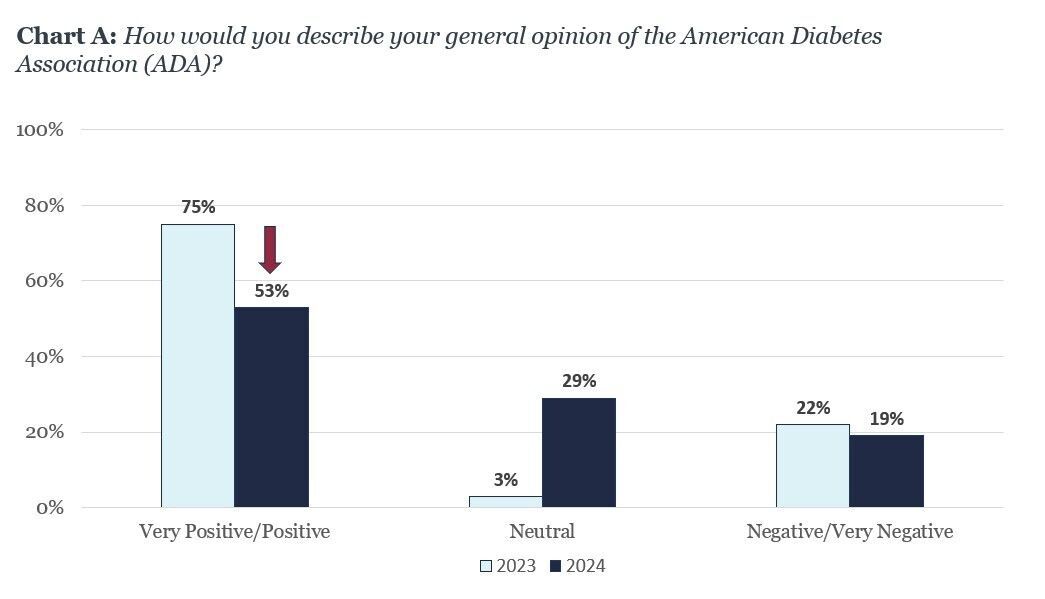
Only 11% of T1D Donors Choose to Give Money to the ADA
When asked which diabetes nonprofit donors would give to if they had to choose, the ADA was the second-to-last choice at 11%. The JDRF continues to be the first choice for donations with 60% of donor preference (see chart B).
The “Other” category took the second highest position at 14%, with respondents inputting their own preferences not otherwise listed. Despite the ability to list any organization, multiple survey takers answered with variations of “any foundation whose sole purpose is funding a Practical Cure in a fixed timeframe.”
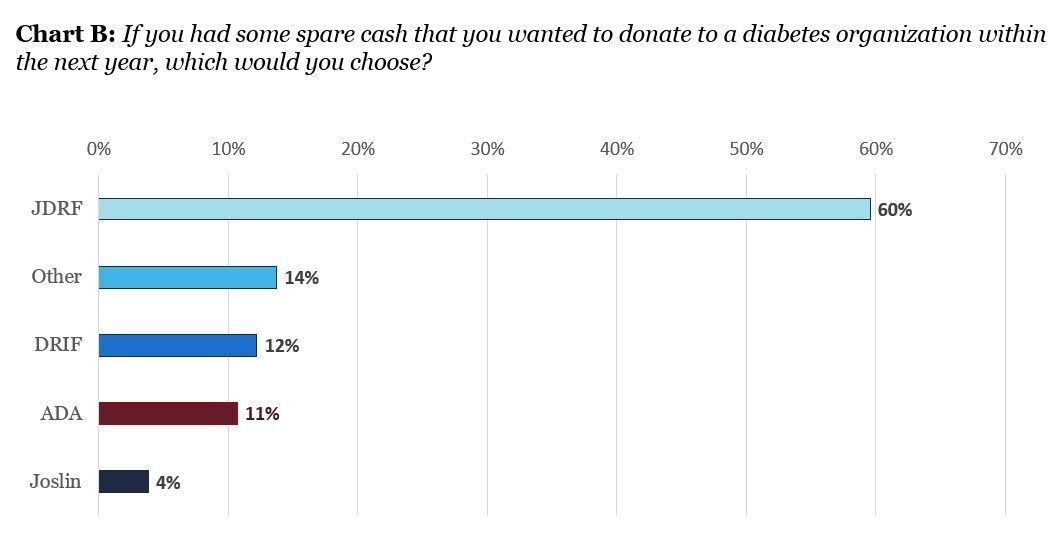
T1D Donors Confused about the ADA’s T1D Commitment
Donors were asked the priority level they believe the ADA places on T1D. 26% of donors believe that T1D is the number one priority of the ADA. Conversely, almost the same number of survey takers (20%) believe that T1D is not seen as a priority or important to the ADA at all (see chart C).
Answers regarding how the ADA views T1D are relatively equal, showing confusion and/or disagreement in how the ADA’s commitment to T1D is perceived.
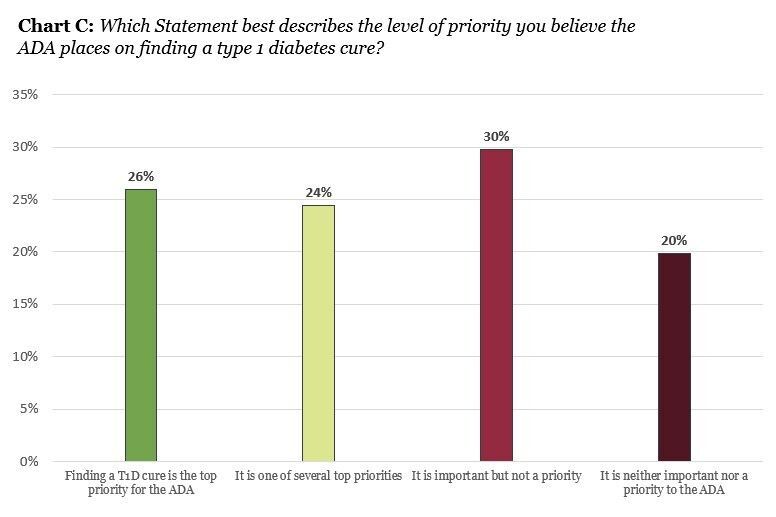
T1D Donors Believe the ADA Does Not Do Enough for a T1D Cure
43% of donors could not name any T1D cure initiatives that are funded by the ADA. The reported answers for each category, “Many,” “Some,” “A Few,” and “None” are almost identical to last year’s results, indicating the ADA funds too few T1D initiatives for donors to gain a real understanding of ADA activities in any given year (see chart D).
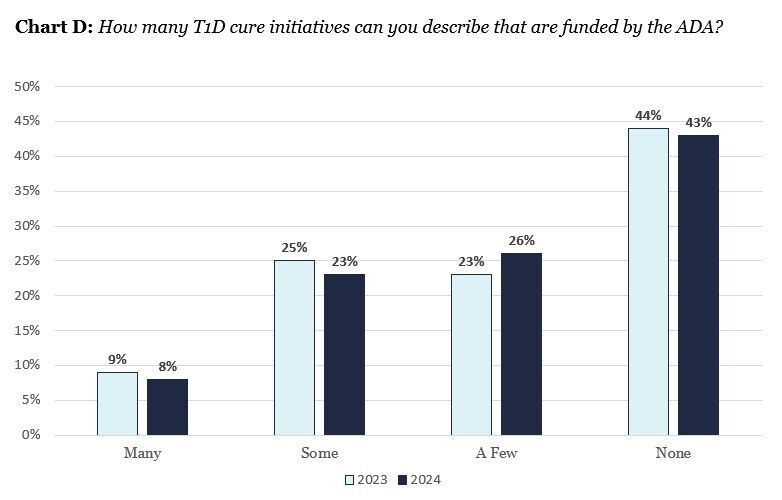
Donors Surprised to Find How Little the ADA Gives to T1D-Focused Initiatives
When survey respondents were presented with the fact that only 3% of the ADA’s annual budget* is used for T1D research initiatives, 62% said they are less likely to donate to the ADA in the future (see chart E).

*source information gathered from the ADA’s website and publicly available financials.
98% of donors said they want the ADA CEO and Board to make a deeper commitment to T1D and cure research. This is a 5 percentage point increase from 2023, indicating that the T1D community is steadfast and growing in their belief that the ADA should increase the importance they place on T1D cure research.
A greater commitment to T1D cure research from the ADA would result in a greater commitment to the ADA from the donor community (see chart F).
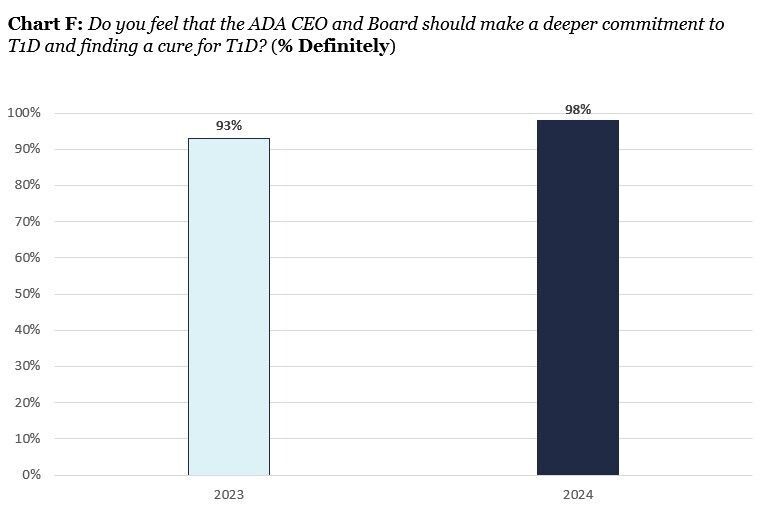
Donors Will Give to the ADA If It Commits to Prioritizing T1D
88% of donors would be “more likely to” or “would definitely” give to the ADA if the organization devoted more of its time and money to T1D cure research (see chart G).
If the ADA increased resources where donors want it most—fueling research for a T1D cure—the ADA could see a large boost in donor contributions and support. If the ADA continues on a path of prioritizing T2D over T1D, and this imbalance is not rectified sooner rather than later, the ADA risks the continued loss of T1D donor loyalty.
We present this data not in a punitive or negative light, but to provide the ADA focused input from the T1D community. If the ADA doubles down on T1D cure research, it will see a revitalization in its reputation and will enjoy increased donations from the T1D community. Following suit, T1D donors would see tangible progress toward a Practical Cure for T1D. These are two sides of the same coin we all want to see.

